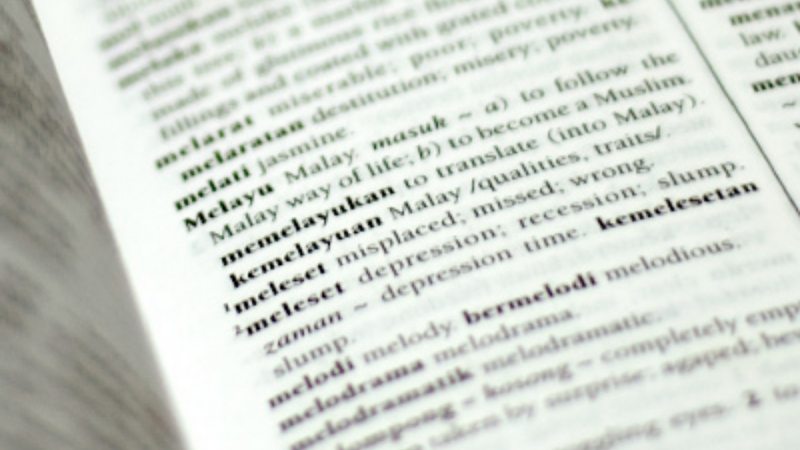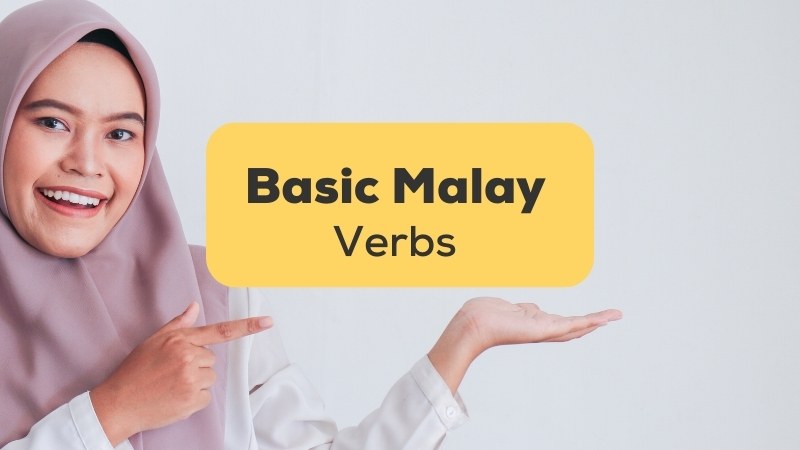When learning a new language (like Spanish, French, or Thai), you definitely look at the basic things that make up the language such as alphabets, greetings, phrases, and words. Today, we’ll look at the words or vocabulary category more specifically – the action words or verbs. For Malay language learners, be ready to learn some of the most basic Malay verbs that you must know!
What Are Malay Verbs?
Like English, Bahasa Malaysia also has its own set of vast vocabulary for verbs; verbs refer to the words people use to describe an action, act, or activity. Verbs in Malay are called kata kerja. In Malaysia, the native speakers have been receiving verb lessons since primary school, which extends to high school and university (specifically if a person studies linguistics).
Are verbs important? Well, like any other culture, our daily lives revolve extremely around verbs and actions. There won’t be a single day where nothing is done – even doing nothing or just lying around is a form of action. It has been a part of our lives and there will never be a time or an era where verbs extinct or cease to exist in our lives. As long as humans live and continue to speak, write and read, such an idea will remain entirely invalid.
Anything To Look Out For In Malay Verbs?

As a Malay native, here’s one thing I should let you know before proceeding with the list of Malay verbs and their examples. A big portion of the Malay verbs are usually accompanied with affixes, mostly the suffixes ber- and me-. Why? Because some of the listed verbs, when not accompanied by suffixes, can stand as nouns, depending on the contexts (such as the words jalan and telefon, which mean road and telephone respectively). This is just a heads up for you, so you wouldn’t get confused later on, seeing why there are other alphabets attached to the verbs.
Another reason why Malay verbs are accompanied by suffixes is to simply produce action-based words. You may want to know that Malay verbs are initially not verbs. Initially, these words are just root words, and in order to produce a whole new word category such as verbs, nouns, or subjects, we add a suffix to the root word. From teaching to teacher and lecture to lecturer; Bahasa Melayu uses this structure too. It’s quite simple if you’ve known English.
So, do you see now how crucial verbs are in our lives? I bet you do. Now, let’s cut to the chase and jump right into learning the common Malay verbs.
Basic Malay Verbs For Beginners
Let’s see, learn, and understand how these basic Malay words are used in the language by going through the examples of all Malay verbs. The list of Malay verbs are put in a sentence and spoken form, just like the following:
1) Tidur – To Sleep
Example 1:
Dia tidur di rumah kawannya.
He sleeps at his friend’s house.
Example 2:
Dah pukul 11 malam, pergi tidur sekarang!
It’s already 11 pm, go to sleep now!
2) Bangun – Wake up
Example 1:
Saya bangun pada jam 5 pagi setiap hari.
I wake up at 5 in the morning every day.
Example 2:
Mia, bangun. Kita dah lambat.
Wake up, Mia. We’re already late.
3) Mandi – Take A Shower
Example 1:
Saya suka mandi awal pagi.
I like to shower early in the morning.
Example 2:
Busuknya kamu! Pergi mandi.
You stink! Go take a shower.
4) Makan – To Eat
Example 1:
Awak nak makan apa hari ini? Saya nak makan spageti.
What do you want to eat today? I want to eat spaghetti.
Example 2:
Saya lapar sangat. Jom makan!
I’m so hungry. Let’s eat!
5) Minum – To Drink
Example 1:
Cik nak minum apa? Saya nak minum jus oren.
What would you like to drink Miss? I want to drink orange juice.
Example 2:
Kopi ada di atas meja. Kamu boleh minum kalau dah siap kerja.
There’s a coffee on the table. You can drink it once you have finished your work.
6) Duduk – To Sit
Example 1:
Boleh saya duduk sebelah awak?
Can I sit next to you?
Example 2:
OK, semua boleh duduk dan buka buku teks masing-masing.
OK, everyone please sit and open your textbooks.
7) Cakap – To Talk
Example 1:
Awak ada masa lapang tak? Saya nak cakap sedikit.
Do you have some free time? I would like to talk.
Example 2:
Apa yang bermain di fikiran kamu? Cakaplah!
What’s on your mind? Say it!
Example 3:
Dia sedang bercakap tentang peristiwa semalam.
He is talking about yesterday’s event.
8) Baca – To Read
Example 1:
Aina, kau baca tak berita malam tadi?
Aina, did you read yesterday’s news?
Example 2:
Ahmad, sila baca rangkap pertama.
Ahmad, please read the first stanza.
Example 3:
Ayah sedang membaca surat khabar.
Father is reading the newspaper.
9) Tulis – To Write
Example 1:
Tuliskan sebuah cerita mengenai seorang ibu yang kaya dan anaknya yang dilupakan.
Write a story about a rich mother and her forgotten son.
Example 2:
Dia sedang menulis sebuah puisi.
He is writing a poem.
*Local Tip: As many verbs are accompanied by suffixes (me- and ber- are the most common ones), some Malay verbs will change spelling afterward. Like the second example, the Malay verb tulis became menulis after the suffix me- is added. Why so? If you’re an English speaker, try pronouncing men-to-list quickly. Yup, as a word, it doesn’t come out that smooth. That’s why most (not all) Malay verbs that start with a ‘T’ will be replaced with an ‘N’ if the suffix me- is added.
10) Buka – To Open
Example 1:
Ali, tolong buka tingkap.
Ali, please open the window.
Example 2:
Ibu membuka pintu.
Mother opens the door.
11) Tutup – To Close
Example 1:
Lelaki itu menutup tingkap bilik.
That man closes the room’s window.
Example 2:
Tolong tutup lampu sebelum kamu beredar.
Please turn off/switch off the lights before you leave.
12) Pakai – To Wear/To Use
Example 1:
Dia memakai baju baru.
He wears a new shirt.
Example 2:
Awak pakai nombor telefon yang mana satu?
Which phone number do you use?
Example 3:
Maaf encik, kami tak pakai mata wang tersebut di Malaysia.
Sorry sir, we don’t use that currency in Malaysia.
*Local tip: The word pakai is synonymous with guna, which means use. If you want to translate the word use to Malay, choose either one – but do learn more to understand how to use these words correctly in terms of meaning (semantics).
13) Buat – To Do
Example 1:
Saya nak buat kerja, jadi tolong jangan ganggu saya.
I want to do my work, so please do not disturb me.
Example 2:
Kamu tengah buat apa?
What are you doing?
14) Guna – To Use
Example 1:
Tolong jangan gunakan kata-kata kesat di sini.
Please do not use profane words here.
Example 2:
Kita hendaklah menggunakan Bahasa Melayu untuk segala urusan rasmi.
We have to use Bahasa Melayu for all official purposes.
15) Jalan – To Walk
Example 1:
Dia sedang berjalan menuju ke jalan utama.
He is walking towards the main road.
Example 2:
Tiap-tiap pagi, dia berjalan ke sekolah.
He walks to school every single day.
Example 3:
Siti berjalan dengan anaknya di dalam taman.
Siti walks with her child in the park.
16) Pergi – To Go
Example 1:
Ahmad pergi ke sekolah.
Ahmad goes to school.
Example 2:
Ibu pergi ke pasar untuk membeli ikan.
Mom goes to the market to buy fish.
Example 3:
Kau buat apa lagi di sini? Pergi buat kerja kau sana!
What are you doing here? Go do your work!
17) Keluar – Go Out/Come Out
Example 1:
Kamu nak ke mana? Saya nak keluar.
Where are you going? I want to go out.
Example 2:
Dia keluar dari bilik setelah dipanggil ibunya.
She comes out of the room after being called by her mother.
Example 3:
Cacing itu keluar perlahan-lahan dari dalam tanah.
The worm comes out slowly from the ground.
18) Masuk – Enter/Go To
Example 1:
Siapa yg masuk ke bilik itu tadi?
Who entered that room just now?
Example 2:
Ahmad tidak masuk kerja hari ini.
Ahmad did not go to work today.
Example 3:
Tolong masukkan semula alamat emel anda.
Please re-enter your email address.
19) Hendak – Want
Example 1:
Kita mesti bekerja keras jika hendak maju.
We must work hard if we want to progress.
Example 2:
Dia hendak melanjutkan pelajarannya ke luar negara.
He wants to further his studies abroad.
Example 3:
Saya nak pergi keluar. Awak mahu ikut?
I want to go out. Do you want to come along?
*Local Tip 1: Hendak is the standard word for want in Bahasa Malaysia. However, in the Malay spoken context, it is abbreviated to nak. Hendak is mostly used for formal occasions and circumstances.
*Local Tip 2: Hendak is synonymous with the Malay word mahu, which also refers to the verb want.
20) Beri – Give/Provide
Example 1:
Sila berikan maklumat peribadi anda.
Please give/provide your personal information.
Example 2:
Kerani itu beri saya dua helai borang.
The clerk gives me two forms.
Example 3:
Kamal memberi layanan istimewa kepada kedua ibubapanya.
Kamal gives special treatment to both of his parents.
21) Naik – Board
Example 1:
Mereka naik lif ke tingkat 4.
They take the elevator to the 4th floor.
Example 2:
“Ini kali pertama saya naik bas,” kata Aminah kepada pemandu bas itu.
“This is my first time boarding a bus,” Aminah told the bus driver.
22) Turun – Get off/Go down
Example 1:
Mereka turun di stesen LRT Gombak.
They get off at the Gombak LRT station.
Example 2:
Saya terpaksa turun ke bandar hari ini.
I had to go down to town today.
23) Tekan – Press
Example 1:
Tekan 1 untuk Bahasa Melayu dan 2 untuk Bahasa Inggeris.
(Operator) Press 1 for Bahasa Melayu and 2 for English.
Example 2:
Boleh awak tolong tekan butang itu untuk saya?
Can you please press that button for me?
24) Gelak – To Laugh
Example 1:
Semua orang gelak melihat tingkah lucu kanak-kanak itu.
Everyone laughs at the child’s funny behavior.
Example 2:
Mereka gelak terbahak-bahak mendengar kisah lucu Adam.
They laugh out loud at Adam’s funny story.
25) Ajak – Invite
Example 1:
Dia ajak saya naik ke rumahnya.
He invited me to his house.
Example 2:
Malaysia telah mengajak Filipina berbincang mengenai perlawanan persahabatan bola sepak.
Malaysia has invited the Philippines to discuss a friendly soccer match.
26) Telefon – Call
Example 1:
Dia telah menelefon pihak polis utk memberitahukan kemalangan jalan raya yg baru berlaku itu.
He has called the police to report the recent road accident.
Example 2:
Tolong telefon ambulans sekarang, isteri saya sudah mahu bersalin!
Please call the ambulance now, my wife is about to give birth!
27) Hantar – Send
Example 1:
Mereka akan hantar saya ke sekolah esok.
They will send me to school tomorrow.
Example 2:
Boleh awak hantar salinan minit mesyuarat tadi?
Can you send me a copy of the minutes of the meeting?
28) Ambil – Take/Get
Example 1:
Boleh awak tolong ambil gambar menu dan hantar pada saya?
Can you please take a photo of the menu and send it to me?
Example 2:
Dia mengambil buku saya tanpa izin.
He took my book without permission.
Example 3:
Saya akan ambil kamu selepas habis sekolah hari ini.
I’ll pick you up after school today.
29) Pinjam – Borrow
Example 1:
Boleh saya pinjam pen awak?
May I borrow your pen?
Example 2:
Dia pinjam 3 buku dari perpustakaan awam.
He borrows 3 books from the public library.
30) Bayar – Pay
Example 1:
Salmah membayar harga kopi dan gula kepada tuan kedai itu.
Salmah paid the price of coffee and sugar to the shop owner.
Example 2:
Bila kamu nak bayar hutang kamu kepada saya?
When are you going to pay your debt to me?
Other Important Verbs In Malay
| MALAY | ENGLISH |
| Pandu | drive |
| Berbasikal | cycling |
| Suka | like |
| Sayang | love |
| Panjat | climb |
| Nyanyi | sing |
| Cetak | |
| Lari | run |
| Lompat | jump |
| Sandar | lean |
| Belajar | learn/study |
| Pegang | touch |
| Tarik | pull |
| Dengar | listen |
| Faham | understand |
| Percaya | trust |
| Khianati | betray |
| Tinggalkan | leave |
| Garu | scratch |
| Menguap | yawn |
How Can You Learn The Malay Language In 2021
Now as we’ve looked at some basic Malay verbs, I think we can agree that Bahasa Melayu is not a difficult language to understand, comprehend, and master. In fact, it’s quite easy and straightforward. However, you need to keep learning as you need to understand the grammar, sentence structure, and all of its linguistic rules to be able to produce grammatically correct Malay written texts. When it comes to speech, you may find your way, speaking Malay and using all these verbs once you found a local who’s willing to teach and share.
Yup, you may want to know that the locals don’t speak all grammatically correct. Like other cultures, the colloquial Bahasa Malaysia is unique and socially structured. It’s quite different from the formal in-class Malay lessons you get in Malaysia’s formal education.
So, if you’re wondering what’s the best way to learn Bahasa Melayu (or any other languages), try Ling App. This app can teach you all the common words, phrases, vocabulary, terms, numbers, grammar and so much more through its interactive lessons. Being on this app will make you stay put because Ling’s content is gamified, just to make your eyes and brains glued to the language lessons. Try Ling App today.














